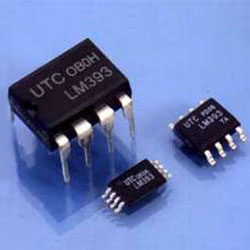
Power Supply Design
Successful IA audio circuits begin with power supply design. Designing low-voltage audio circuits for portable and wireless information appliance products puts severe restrictions on quality.
Sacrifices necessary to keep cost, size, and weight to a minimum often hurt audio quality.
Portable and wireless devices force audio designers to work with very small supply voltages, often just a single 1.5-volt cell. There is just one rule when designing quality audio circuits if you only have 1.5 volts to work with: make more voltage.
Separate Audio Supply
No matter what the voltage, in order to achieve very high performance levels, audio circuitry must run from dedicated supplies.
Obviously it does no good to select the lowest noise op amps if they are connected to a digitally corrupted power supply.
Single-Supply Design
If the design cannot justify split-supply costs then you must design with a single supply. Since audio is an AC (alternating current) signal, its voltage swings positive and negative about some reference point.
This reference point is normally ground (or common) for a bipolar or dual power supply, i.e., one with positive and negative voltages (e.g. ±15 VDC). If you only have a single supply then you must create a reference point equal to one-half of the available supply.
For example if you have a single 5 volt supply then you create a common reference point at 2.5 volts, which allows the audio to swing ±2.5 volts (from the reference point up 2.5 volts to the +5 volt limit and down 2.5 volts to zero.
Splitting a single supply voltage is not difficult, nor expensive (although in some designs every extra op amp or resistor can mean trouble).
Techniques exist ranging from a simple two-resistor voltage divider to more elaborate buffered op amp designs. Excellent application notes covering all aspects of this topic are available from Texas Instruments, Linear Technology, and Analog Devices.
DC-DC Converters
If the hand you’ve been dealt contains only one AA cell battery then you must become a DC-DC converter designer at once. Luckily there is lots of help in this area. There’s nothing you can do with a single AA battery except use it to create more voltage.
How much voltage depends on the product and the application. If you must create loud audio into big speakers, then life’s going to be a lot harder than if you can get away with driving only headphones.
Low efficiency loudspeakers and headphones are a big obstacle to pristine IA audio. Low efficiency means you need lots of power to drive high-quality speakers to loud levels. And lots of power means lots of voltage and current.
If it is your choice, then chose a pair of nice clean and quiet split supply voltages—as high as you can get them for loud results or if you are going to interconnect with the pro audio world. Most pro audio products use ±15 VDC for their analog audio circuits.
While finding a single IC capable of converting 1.5 VDC to a nice clean and quiet ±15 VDC is difficult (see LTC Design Note) to impossible, several IC companies make converters that will pump up 1.5 volts to 12 volts, and from there you can split that into a useable ±6 VDC. See for instance Analog Devices or Linear Technology, or also Linear Technology.
See also Linear Tech’s latest free design software for DC-DC converters, although it doesn’t help much for single cell converters.
Another free helpful DC-DC converter design program is available from National Semiconductor named Switchers Made Simple , and take a look at the collaborative venture by National, Vishay, and Pioneer-Standard Electronics called Webench , a free on-line tool to design, simulate and order prototype kits for power supplies.
And not-for-free from ON Semiconductor is Power 4-5-6 software for the design, simulation and analysis of power topologies.
